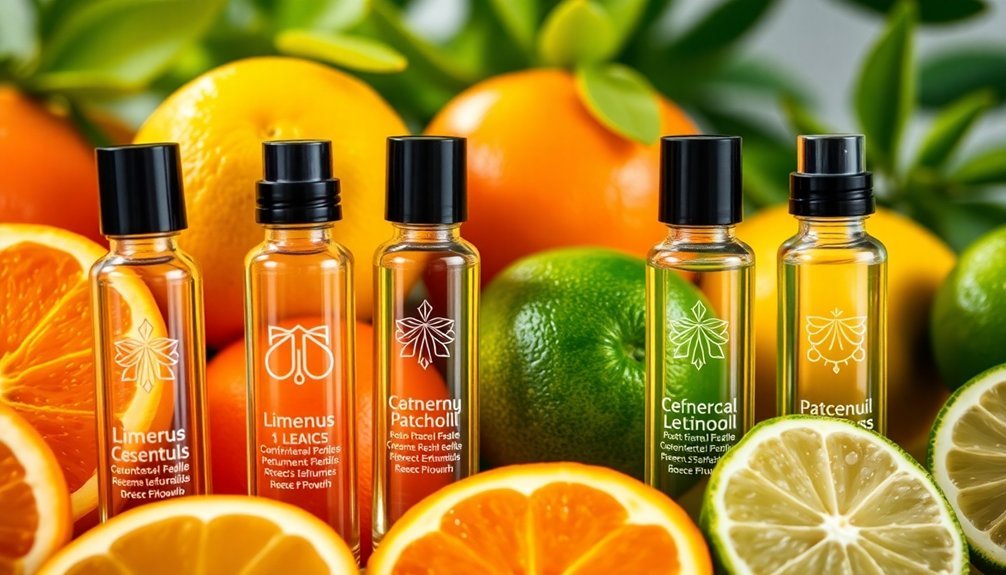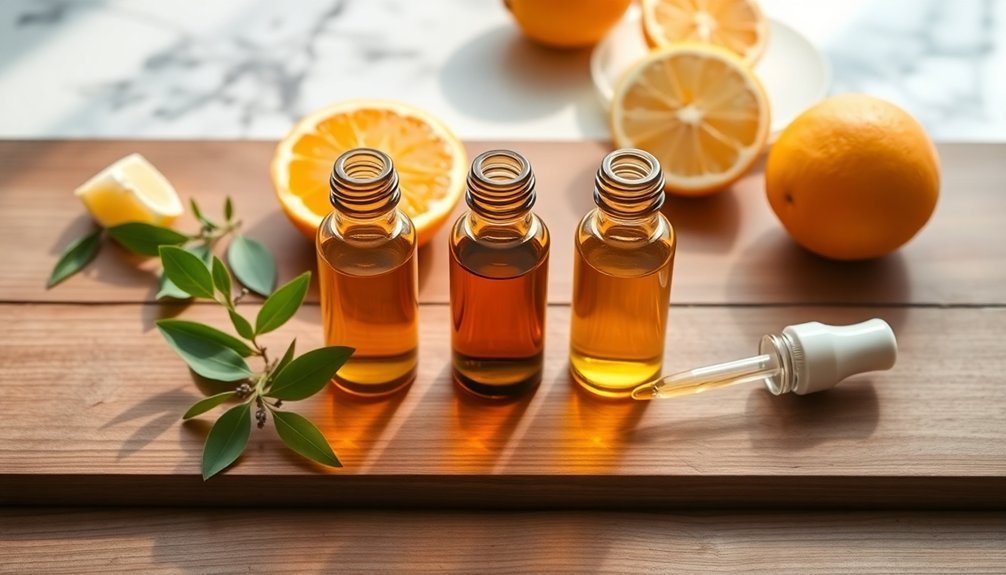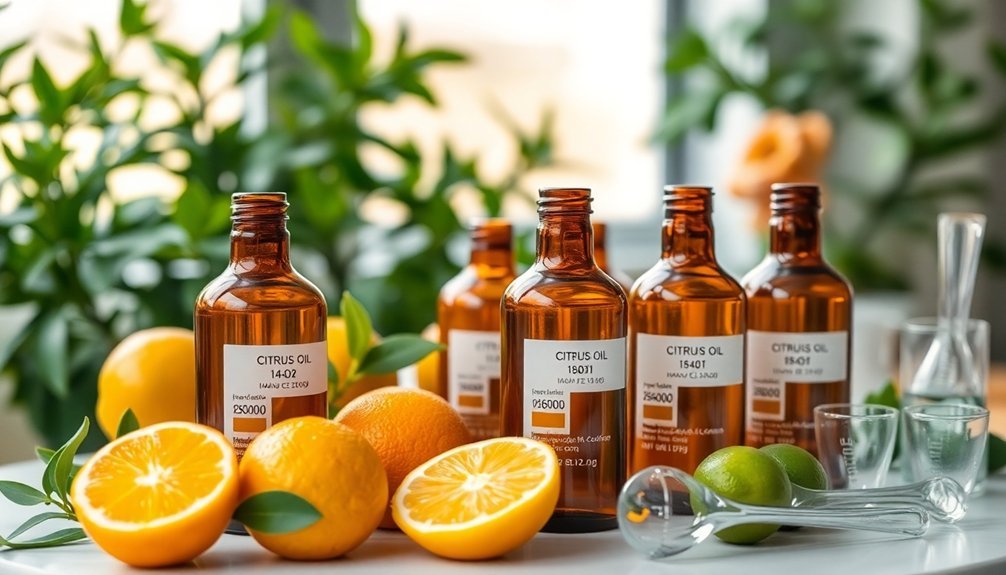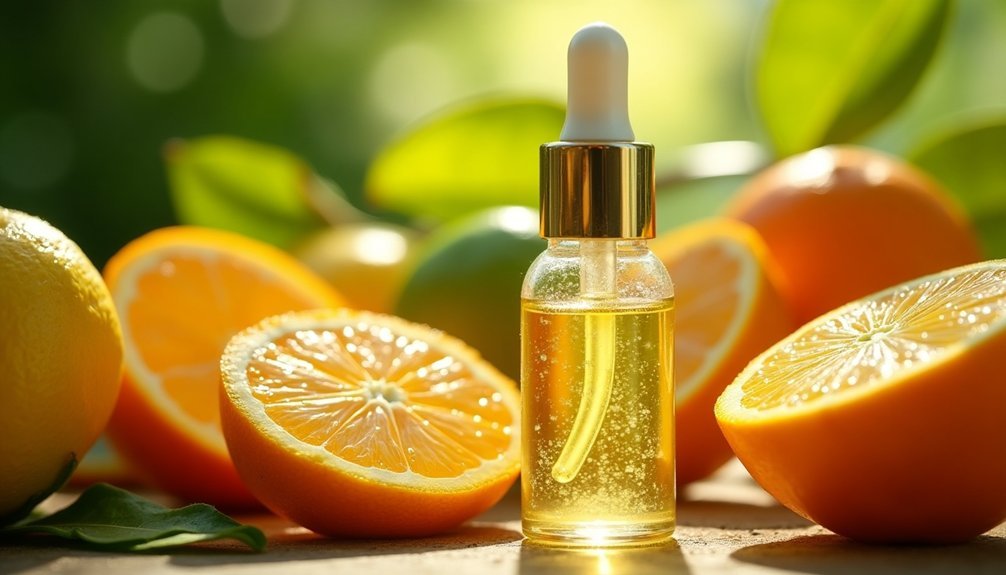To create your signature citrus perfume, start with a balanced 30:50:20 ratio – that's 30% citrus top notes, 50% middle notes (like florals or spices), and 20% base notes (such as woods or resins). For a beginner's blend, use 10 drops total: 3 drops citrus, 5 drops middle note, and 2 drops base note. Let your blend rest for 24 hours to harmonize. While these ratios provide a solid foundation, mastering the art of personalized perfumery reveals countless aromatic possibilities.
Understanding Basic Citrus Oil Blending Ratios

Anyone interested in citrus essential oil blending should start with understanding the basic 30:50:20 ratio – that's 30% top notes, 50% middle notes, and 20% base notes.
For a beginner's blend, you'll want to start with just 10 drops total, which translates to 3 drops of citrus oil (top note), 5 drops of your chosen middle note, and 2 drops of a base note.
Since citrus oils are naturally light and evaporate quickly, they work perfectly as top notes in your blend. Using proper dilution with carrier oils helps prevent skin irritation while maintaining the fragrance profile.
After mixing your oils, let them rest for 24 hours to achieve complete harmonization.
You can pair your citrus oils with complementary scents like lavender, peppermint, or woody oils for a balanced fragrance.
Just remember to avoid applying citrus blends before sun exposure due to phototoxicity risks.
The Science Behind Citrus and Patchouli Combinations
When you're combining citrus and patchouli oils, you're creating more than just a pleasant fragrance—you're orchestrating a molecular symphony of complementary compounds.
The bright, sweet molecules of citrus oils interact with patchouli's complex, earthy compounds to create a balanced and stable aromatic profile. The recommended three to one ratio of patchouli to citrus oils creates the ideal molecular balance for a signature scent.
You'll find this combination particularly effective because patchouli's heavier base notes anchor the lighter, more volatile citrus molecules, resulting in a longer-lasting and more harmonious blend.
Balance Sweet With Earthy
Discovering the perfect balance between citrus and patchouli essential oils requires understanding their unique molecular interactions.
You'll find that sweet and earthy notes complement each other when properly balanced, creating a harmonious blend that's both uplifting and grounding. For optimal safety and quality, ensure you're working with phthalate-free formulations to create the purest possible blends.
- Start with a 3:1 ratio when combining orange or lemon with patchouli, adjusting to 4:1 for grapefruit due to its lighter scent profile.
- Layer your blend with middle notes like violet or rose geranium to create a smooth progression between citrus and earthy bases.
- Add depth with complementary base notes such as oakmoss or cedarwood to enhance the patchouli's grounding effect.
- Consider your final product's application – soaps may require higher citrus ratios to maintain scent longevity, while perfumes can follow standard ratios.
Molecular Harmony Principles
The intricate molecular dance between citrus and patchouli essential oils reveals why these seemingly opposite scents work so well together.
At its core, patchouli's primary compound, patchoulol, displays remarkable adaptability, shifting between base and top notes to complement your citrus choices.
You'll find the magic happens in the ratios – aim for 3:1 or 4:1 citrus to patchouli to create balanced blends.
The chemistry behind this harmony lies in patchouli's ability to morph its essence, much like a chameleon, while citrus provides the bright, lifting notes.
As your blend ages, patchouli's aroma deepens and mellows, creating even more complexity.
When you're crafting your signature scent, remember that molecular structures matter – patchoulol's versatility allows it to interact harmoniously with citrus compounds, creating a stable, long-lasting fragrance.
Selecting Complementary Base Notes for Citrus Oils

When you're working with citrus essential oils, you'll need strong base notes to anchor their light, volatile nature.
Base notes like sandalwood, patchouli, and cedarwood provide the perfect foundation, extending the life of your citrus blends through their heavier molecular structure.
Dark woods particularly complement orange oils, creating a balanced interplay between bright, uplifting notes and deep, grounding undertones.
Base Notes Anchor Citrus
Since citrus oils naturally evaporate quickly, choosing the right base notes can transform your blend from fleeting to long-lasting.
You'll want to select base notes that not only complement your citrus scents but also provide the necessary foundation to make your fragrance endure throughout the day.
- Add earthy depth with patchouli or vetiver to ground your citrus blend while creating a harmonious balance.
- Incorporate woody notes like cedarwood or sandalwood to enhance the richness and complexity of your fragrance.
- Choose floral bases such as jasmine or rose to soften citrus sharpness and add a romantic dimension.
- Select musky or resinous notes like vanilla, frankincense, or myrrh to provide warmth and improve staying power.
Your signature scent will gain sophistication and longevity when you anchor your citrus oils with these strategic base notes.
Dark Woods Meet Orange
Creating dark, sophisticated blends with citrus oils comes alive when you pair them with woody base notes. Cedarwood and sandalwood are your best allies, offering a grounded foundation that transforms bright orange notes into elegant compositions.
You'll find that cedarwood adds depth while maintaining the citrus's vibrancy. For a more complex profile, try combining orange with patchouli's earthy undertones or vetiver's sweet woodiness. These combinations create a multidimensional fragrance that evolves beautifully on your skin.
If you're aiming for a fresher woody undertone, cypress is your go-to choice – it preserves the citrus's natural brightness while adding sophistication. Remember to start with a small amount of your chosen wood note, as these bases are potent and can easily overshadow the delicate orange top notes.
Balancing Sweet and Tart Citrus Notes
Balancing sweet and tart citrus notes requires a careful understanding of each oil's unique characteristics.
You'll find that orange and bergamot provide sweeter profiles, while lime and grapefruit deliver sharper, more energetic notes. To create a well-rounded citrus blend, you'll want to take into account both the intensity and the character of each oil.
- Mix orange with lime or grapefruit to create a balanced sweet-tart profile
- Use bergamot as a bridge between sweeter and sharper citrus notes
- Combine lemon with orange for a bright yet rounded daytime scent
- Layer grapefruit with sweeter citrus oils to soften its bitter edge
Remember to maintain proper solubilizer ratios when working with citrus oils, typically starting at 3:1 (solubilizer:oil) and adjusting as needed for clarity.
Essential Carrier Oils for Citrus-Based Perfumes

Selecting the right carrier oil forms the foundation of a successful citrus-based perfume. You'll want to focus on carriers that enhance longevity while maintaining the bright, fresh qualities of citrus notes.
Mango seed oil proves ideal for citrus blends, as it naturally complements and extends the life of these volatile fragrances. For best results, combine it with fractionated coconut oil, which offers excellent stability and a non-greasy finish that won't compete with your citrus notes.
If you're seeking additional depth, consider jojoba oil's odorless nature and remarkable stability. It won't interfere with your citrus scents while providing lasting power.
For those who prefer a lighter touch, grapeseed oil's neutral profile makes it perfect for preserving the pure, crisp essence of your citrus elements.
Creating Long-Lasting Citrus Fragrances
While citrus oils captivate with their bright, uplifting scents, their volatile nature poses a challenge for perfume makers seeking lasting fragrances.
You'll need to employ specific techniques to extend their longevity and create a more enduring citrus perfume.
To achieve a long-lasting citrus fragrance:
- Layer your citrus oils with middle notes like lemongrass or lavender, and base notes such as vanilla or frankincense to create depth and staying power.
- Apply your perfume to well-moisturized skin, focusing on pulse points without rubbing.
- Store your blend in dark glass containers away from heat and sunlight.
- Follow a balanced ratio of 30% top notes (citrus), 50% middle notes, and 20% base notes when mixing your oils.
These strategies will help transform your fleeting citrus scents into longer-lasting signature fragrances.
Seasonal Citrus Blend Adjustments

When crafting your citrus essential oil blends, you'll need to adjust your ratios considerably between summer and winter, with summer blends typically requiring 15-20% lower concentrations due to increased volatility in heat.
You'll want to account for humidity levels by increasing oil concentrations in dry winter air and decreasing them in humid summer conditions to maintain consistent scent projection.
Temperature changes directly affect how oils evaporate and interact, so you'll need to modify your proportions—using more base notes in summer to anchor the blend and more top notes in winter to enhance diffusion.
Summer Vs Winter Ratios
The art of blending citrus essential oils requires significant adjustments between summer and winter months to achieve the perfect fragrance.
Summer blends call for higher proportions of bright citrus oils and lighter base notes, while winter formulations need warmer, richer components to create seasonal harmony.
- Summer blends should follow a 25/40/20 ratio, emphasizing fresh top notes like lemon and bergamot, paired with light florals and subtle woody base notes.
- Winter blends shift to a 20/40/40 ratio, incorporating warmer citrus like mandarin with spicy middle notes and heavier bases.
- You'll want to reduce citrus proportions by 5-10% in winter blends, compensating with warming spices like cinnamon and clove.
- Base notes require the most dramatic seasonal adjustment – light cedarwood for summer versus rich patchouli or sandalwood for winter.
Humidity Impact Adjustments
Successfully blending citrus essential oils requires careful consideration of humidity levels throughout the year.
You'll need to increase the concentration of your citrus oils during humid conditions since high humidity reduces their volatility and makes fragrances less intense.
When humidity is high, your citrus blends should be 25-30% stronger than usual to counteract the reduced odor diffusion.
Since humid air already contains water vapor that interferes with scent molecules reaching your olfactory receptors, you'll want to focus on bright, sharp notes like lemon, grapefruit, or bergamot.
In drier conditions, you can use standard ratios since the scents will naturally project better.
Remember to adjust your diffuser settings accordingly – use a higher output in humid weather and a lower setting when it's dry.
Temperature-Based Oil Proportions
Adapting your citrus essential oil blends to seasonal temperature changes guarantees ideal fragrance performance throughout the year.
During warmer months, you'll want to focus on lighter, more stimulating combinations using bergamot and lemon oils, while colder seasons call for richer blends featuring orange blossom and neroli.
- For summer blends, combine bergamot, lemon, and mandarin oils at a 15% dilution rate to create an invigorating scent that won't become overwhelming in the heat.
- Winter formulations work best with a 20% concentration, mixing orange blossom, neroli, and grapefruit for depth.
- Add yuzu to summer blends for a unique citrus profile that balances mandarin and grapefruit notes.
- Ground winter blends with patchouli or woody notes to create sophisticated, season-appropriate fragrances.
Safety Guidelines for Citrus Oil Concentrations

Safe handling of citrus essential oils requires strict adherence to concentration guidelines to prevent adverse skin reactions and phototoxicity.
When formulating with citrus oils, you'll need to keep the furocoumarin content below 1 mg/kg in your final product, with 5-MOP levels not exceeding 0.0015% (15 ppm).
For general aromatherapy blends, dilute your citrus oils to 1-5% concentration. If you're creating perfumes, maintain a ratio of 20% fragrance to 80% carrier agent.
For sensitive skin or children, reduce concentrations to 0.5-2.5%. Always perform a patch test before using new oils, and discontinue use if you notice any irritation or redness.
Remember that fair-skinned individuals need extra caution, as they're more susceptible to sunburn when using citrus oils.
Measuring and Mixing Techniques for Citrus Blends
Creating professional citrus oil blends requires mastering three fundamental mixing techniques: single-note blending, multi-note blending, and the 30/50/20 ratio rule.
When you're working with citrus oils, precision in measurement guarantees consistent, balanced results every time.
- Start with glass bottles and add oils drop by drop, following the 30/50/20 ratio (3 drops top note, 5 drops middle note, 2 drops base note for a 10-drop blend).
- Use perfume testing strips to evaluate your blend's harmony without wasting oils.
- Take breaks between testing to avoid olfactory fatigue, which can skew your perception.
- Record your measurements precisely, noting which citrus oils you've combined and their exact proportions.
Remember to combine complementary notes, such as pairing citrus top notes with floral middle notes and woody base notes for a well-rounded fragrance.
Top Note Variations With Different Citrus Oils

While all citrus oils share bright and energetic qualities, each variety offers distinct aromatic characteristics that can transform your top note blends. You'll find that lemon brings an uplifting, crisp freshness, while orange adds a sweet, versatile warmth. Bergamot's intense citrusy profile can work as both a top and middle note, making it exceptionally versatile in your formulations.
| Oil Type | Key Characteristics | Best Blending Partners |
|---|---|---|
| Lemon | Fresh, volatile, uplifting | Ginger, clove, florals |
| Orange | Sweet, pleasing, versatile | Cinnamon, vetiver, cloves |
| Grapefruit | Sharp, tangy, zesty | Basil, frankincense, ylang ylang |
| Bergamot | Intense, invigorating, complex | Lavender, eucalyptus, other citrus |
Remember to evaluate phototoxicity when working with these oils, and always properly dilute them before use.
Customizing Your Signature Citrus Scent
Building your signature citrus scent requires a thoughtful balance of essential oil ratios and complementary notes. Start with a 20% essential oil concentration in your carrier oil mixture, adjusting to 15% if you have sensitive skin. For a harmonious blend, follow the 30/50/20 rule while incorporating your chosen citrus oils.
- Use a pipette to measure precise amounts, starting with bergamot or sweet orange as your primary citrus note.
- Add depth with complementary middle notes like ginger or rose, keeping the total blend around 10 drops initially.
- Include grounding base notes such as cedarwood or vanilla to complete your signature scent.
- Let your blend rest for at least 24 hours, then test it on paper strips before applying to skin.
Shake well before each use and allow your perfume to mature for ideal fragrance development.
Perfecting the Middle Note Balance

Middle notes form the heart of your citrus perfume blend, serving as the essential bridge between bright top notes and deep base notes.
You'll want to dedicate 50-75% of your blend to middle notes, carefully selecting from floral, herbal, or spicy elements that complement your citrus foundation.
Try combining jasmine, ylang ylang, or rose for depth, or add lavender and geranium for a revitalizing balance. If you're seeking warmth, incorporate cinnamon or pepper.
Start with the drop-by-drop method, adding one drop of each chosen note before fine-tuning the ratios. As you experiment, pay attention to how the fragrance evolves over 20-60 minutes after application.
Test different combinations until you achieve a harmonious blend that maintains its inviting character while shifting smoothly between layers.
Storage and Shelf Life of Citrus Perfumes
Since citrus essential oils are particularly sensitive to environmental factors, proper storage becomes crucial for maintaining their vibrant character and extending their shelf life.
You'll need to be extra cautious with citrus-based perfumes as they tend to evaporate more quickly than other fragrances. Store your creations in dark, cool places, away from bathrooms and direct sunlight to prevent premature degradation.
- Keep bottles tightly sealed and upright to minimize oxygen exposure, which can break down the fragrance.
- Store perfumes in their original packaging, which provides optimal protection against light and air.
- Don't shake the bottles, as this creates bubbles that can accelerate oxidation.
- Consider your skin type when applying, as oily skin will help your citrus perfume last longer than dry skin.
Frequently Asked Questions
Can I Mix Citrus Oils With Synthetic Fragrances in My Perfume Blend?
Yes, you can mix citrus oils with synthetic fragrances in your perfume blends. It'll enhance scent longevity, create unique combinations, and offer more sustainable options while giving you greater creative flexibility in fragrance development.
How Do Citrus Essential Oils Interact With UV Exposure and Sunlight?
You'll need to be careful as phototoxic citrus oils can cause severe skin reactions when exposed to UV light. They'll make your skin more sensitive and can lead to burns, blistering, or discoloration.
Do Citrus Oils Stain Fabrics When Used in Perfume Blends?
Yes, citrus oils can stain your fabrics, especially on natural fibers like cotton and silk. You'll want to let your perfume dry completely before dressing and test it first on an inconspicuous spot.
Which Citrus Oils Are Considered Photosensitive Versus Non-Photosensitive?
You'll find cold-pressed bergamot, grapefruit, lemon, lime, and bitter orange are photosensitive, while steam-distilled versions and sweet orange aren't. FCF bergamot is also safe from phototoxic effects.
Can Pregnant Women Safely Use Citrus-Based Perfume Blends?
You can safely use citrus-based perfumes during pregnancy. They're often recommended for their gentle nature and can help with nausea. Just be mindful of your increased sensitivity and use them moderately to avoid discomfort.
In Summary
You've now mastered the art of blending citrus essential oils for your signature perfume. Take these ratios and combinations as your starting point, but don't be afraid to experiment with your own unique twist. Remember to store your creations in dark amber bottles and keep them cool to preserve their vibrant notes. With practice and patience, you'll create stunning citrus perfumes that perfectly capture your personality.
References
- https://nikura.com/blogs/make-at-home/how-to-make-perfume
- https://www.mdpi.com/2075-4450/11/5/309
- https://www.immortalperfumes.com/blog/how-to-make-perfume
- http://eprints.upjb.ac.id/id/eprint/167/1/A Framework for Marketing Management by Philip T Kotler
- https://www.soapmakingforum.com/threads/patchouli-citrus-eo-need-ratio-advice.8058/
- https://www.newdirectionsaromatics.com/blog/blending-and-diluting-essential-oils/
- https://gyalabs.com/blogs/diy-recipes/citrus-sunshine-refreshing-diy-recipes
- https://africaimports.com/blog/the-ultimate-guide-to-making-perfume-with-essential-oils/
- https://www.natio.com.au/blogs/discoveries/how-to-create-your-own-essential-oil-blend
- https://aromaland.com/20CIG





Leave a Reply